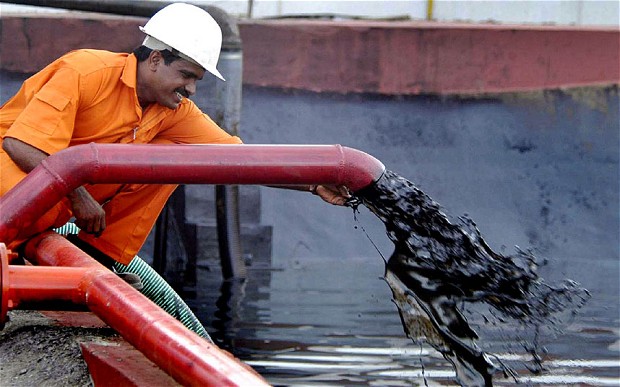However, the sharp drop in prices in June - in connection with the nuclear agreement on Iran, the permanent surplus of supply and economic problems in Greece and China - has worsened market sentiment.
Now, the view, that oil prices could fall even lower and this will be a strong blow to the oil and gas sector, is prevailing.
Oil futures for delivery in December 2020 are currently traded at $ 8 lower than they were at the beginning of the year, while spot prices rose to $ 4.
In other words, oil traders are now much more pessimistic about the outlook for crude oil in the coming years.
There is a growing realization that oil prices may remain very low, and it launches a new round of spending cuts and layoffs in the oil industry.
- This is a monumental task, to offset the impact of falling oil prices by 50% - says the analyst of Oppenheimer & Co. Fadel Gheit. - Priorities have shifted completely. The priority now is just to stop spending budget and live within the means. Forget about growth. Now companies are in survival mode.
Many companies have also re-counted the price of oil needed for new drilling projects so that they would have at least some financial sense. According to the Wall Street Journal, BP expect prices to reach $ 60 per barrel, and now activities are scheduled on the basis of this price. The Royal Dutch Shell is a little more pessimistic, using the level of $ 50 per barrel.
Currently, all projects that require the price of $ 100 a barrel or more, are just postponed indefinitely, even if they have already been started.
Major oil companies have canceled or delayed projects by $ 200 billion, Wood Mackenzie calculated.
Worldwide, 46 major oil and gas projects are delayed, the total amount of reserves reaches 20 billion barrels of oil equivalent. This means that in a few years, global production could be significantly lower than expected.
Due to the long periods, the decisions, taken today, will have an impact towards the end of this decade, as well as in the 2020s.
For companies, of course, it is important to reduce costs now, but the overall trend could lead to a total deficit of oil.
Predicting the volume of demand in the long term is very difficult, and this problem is a characteristic of all economic and financial models. No one really cannot say how much oil the world will need in 10 or 20 years. Although, production volumes can be predicted more or less accurately.
Another problem is that even on the back of high oil prices, the number of discoveries of large deposits decreased markedly. 2014th, in which prices were still high, was one of the worst periods in the last 60 years in terms of new discoveries of large deposits.
Despite the high level of expenditure, exploration companies are simply finding less oil.
Extraction of shale oil increased in recent years, but it may be a passing phenomenon. The rapid rate of decline in the number of shale wells suggests that production in the US may fall in the future the next few months.
Nevertheless, America can still maintain the current level, but it is unclear how much it will cost, as it would require the widespread adoption of new technologies.
The IEA predicts that oil shale in the United States will be stable and will begin to decline in the 2020s. This means that to keep up with the growing demand will not be possible.
We also add that most of the shale wells occur within the first 1-2 years, but the traditional wells are losing volume at a rate of about 5% per year. And that means that very soon the world will require major new sources of oil.
Another factor that can recoup the oil markets in the long term - is to use the spare capacity of Saudi Arabia. It is believed that the kingdom could boost production in a few weeks and it is crucial for the stability of the world oil market.
Many energy analysts like to compare the current situation with the one that occurred in 1980. But one of the main differences is that in addition to the glut of oil supplies in the 1980s, Saudi Arabia cut production sharply from 10 million barrels per day to less than 4 million barrels per day.
As a result, during the second half of the '80s and throughout the 90s, the world faced a spare capacity of several million barrels a day, so during that time there was virtually no chance of a rise in prices.
Now, according to various estimates, even OPEC has only 1.6 million barrels per day of spare capacity, which is the lowest level since 2008. Thus, Saudi Arabia is currently flooding the market with their oil, but there is almost no possibility of increasing production .
This brings us to the major oil companies reducing costs. Standby power is not presented, there is just a few of new fields, and the world may ultimately be faced with a noticeable drop in demand. Nevertheless, it can lead to a sharp and strong growth in oil prices - although we have to wait another 5-7 years.
based on Nick Cunningham's materials, Oilprice.com
Now, the view, that oil prices could fall even lower and this will be a strong blow to the oil and gas sector, is prevailing.
Oil futures for delivery in December 2020 are currently traded at $ 8 lower than they were at the beginning of the year, while spot prices rose to $ 4.
In other words, oil traders are now much more pessimistic about the outlook for crude oil in the coming years.
There is a growing realization that oil prices may remain very low, and it launches a new round of spending cuts and layoffs in the oil industry.
- This is a monumental task, to offset the impact of falling oil prices by 50% - says the analyst of Oppenheimer & Co. Fadel Gheit. - Priorities have shifted completely. The priority now is just to stop spending budget and live within the means. Forget about growth. Now companies are in survival mode.
Many companies have also re-counted the price of oil needed for new drilling projects so that they would have at least some financial sense. According to the Wall Street Journal, BP expect prices to reach $ 60 per barrel, and now activities are scheduled on the basis of this price. The Royal Dutch Shell is a little more pessimistic, using the level of $ 50 per barrel.
Currently, all projects that require the price of $ 100 a barrel or more, are just postponed indefinitely, even if they have already been started.
Major oil companies have canceled or delayed projects by $ 200 billion, Wood Mackenzie calculated.
Worldwide, 46 major oil and gas projects are delayed, the total amount of reserves reaches 20 billion barrels of oil equivalent. This means that in a few years, global production could be significantly lower than expected.
Due to the long periods, the decisions, taken today, will have an impact towards the end of this decade, as well as in the 2020s.
For companies, of course, it is important to reduce costs now, but the overall trend could lead to a total deficit of oil.
Predicting the volume of demand in the long term is very difficult, and this problem is a characteristic of all economic and financial models. No one really cannot say how much oil the world will need in 10 or 20 years. Although, production volumes can be predicted more or less accurately.
Another problem is that even on the back of high oil prices, the number of discoveries of large deposits decreased markedly. 2014th, in which prices were still high, was one of the worst periods in the last 60 years in terms of new discoveries of large deposits.
Despite the high level of expenditure, exploration companies are simply finding less oil.
Extraction of shale oil increased in recent years, but it may be a passing phenomenon. The rapid rate of decline in the number of shale wells suggests that production in the US may fall in the future the next few months.
Nevertheless, America can still maintain the current level, but it is unclear how much it will cost, as it would require the widespread adoption of new technologies.
The IEA predicts that oil shale in the United States will be stable and will begin to decline in the 2020s. This means that to keep up with the growing demand will not be possible.
We also add that most of the shale wells occur within the first 1-2 years, but the traditional wells are losing volume at a rate of about 5% per year. And that means that very soon the world will require major new sources of oil.
Another factor that can recoup the oil markets in the long term - is to use the spare capacity of Saudi Arabia. It is believed that the kingdom could boost production in a few weeks and it is crucial for the stability of the world oil market.
Many energy analysts like to compare the current situation with the one that occurred in 1980. But one of the main differences is that in addition to the glut of oil supplies in the 1980s, Saudi Arabia cut production sharply from 10 million barrels per day to less than 4 million barrels per day.
As a result, during the second half of the '80s and throughout the 90s, the world faced a spare capacity of several million barrels a day, so during that time there was virtually no chance of a rise in prices.
Now, according to various estimates, even OPEC has only 1.6 million barrels per day of spare capacity, which is the lowest level since 2008. Thus, Saudi Arabia is currently flooding the market with their oil, but there is almost no possibility of increasing production .
This brings us to the major oil companies reducing costs. Standby power is not presented, there is just a few of new fields, and the world may ultimately be faced with a noticeable drop in demand. Nevertheless, it can lead to a sharp and strong growth in oil prices - although we have to wait another 5-7 years.
based on Nick Cunningham's materials, Oilprice.com






